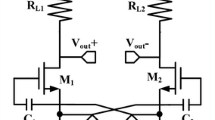Abstract
A 0.5–2.5 GHz ultra low power differential resistive feedback common gate low noise amplifier (RFCGLNA) without the use of inductor is presented. The proposed RFCGLNA adopts the NMOS and PMOS complementary topology to reduce the power consumption by half. Based on common-gate topology, the proposed RFCGLNA employs capacitive cross-coupling (CCC) and resistive feedback techniques. The CCC technique can further reduce the power consumption by half. The resistive feedback technique can constrain the common mode voltages of the proposed RFCGLNA and meanwhile, improve the third-order input intercept point (IIP3). The DC path is supplied by the current source transistor which forms a positive feedback loop to improve the gain at low frequency. Implemented with 65 nm standard complementary metal oxide semiconductor (CMOS) technology, the measured performance achieves 15 dB gain with S11 < −10 dB in the 0.5–2.5 GHz band. The noise figure (NF) is 3.9–5.0 dB and the IIP3 is 3.1–3.6 dBm. The power consumption is only 910 uW.


















Similar content being viewed by others
References
Kuo, M. C., Kao, S. W., Chen, C. H., Hung, T. S., Shih, Y. S., Yang, T. Y., et al. (2009). A 1.2 V 11mW dual-band direct-conversion DVB-H Tuner in 0.13um CMOS. IEEE Journal of Solid-State Circuits, 44(3), 740–750.
D. Manstretta and L. Dauphinee. (2007). A Highly Linear Broadband Variable Gain LNA for TV Applications, Proc. IEEE Custom Integrated Circuits Conf. (CICC), 531–534.
Vidojkovic, V., van der Tang, J., Leeuwenburgh, A., & van Roermund, A. (2008). Adaptive Multi-Standard RF Front-Ends. Dordrecht: Springer.
Sivonen, P., & Pärssinen, A. (2005). Analysis and optimization of packaged inductively degenerated common-source low-noise amplifiers with ESD protection. IEEE Tran. on Microwave and Techniques, 53(4), 1304–1313.
R.S. Rana, Zhang Liang and H.K. Garg. (2006). Sub-mA single ended CMOS low noise amplifier with 2.41 dB noise figure.
Im, D., Kim, H. T., & Lee, K. (2012). A CMOS resistive feedback differential low-noise amplifier with enhanced loop gain for digital tv tuner applications. IEEE Tran. on Microwave and Techniques, 57(11), 2633–2642.
Youchun Liao, Zhangwen Tang, and Hao Min. (2007). A CMOS wide-band low-noise amplifier with balun-based noise-cancelling technique, Proc. of Asian Solid-State Circuits Conf., 91-94.
Chia-Hung chang, Tao Wang and C.F. Jou. (2012). Dual cross-coupling LNA with forward body bias technique, IEEE Electronics Letter, 48(18), 1341–1342.
A. Liscidini, C. Ghezzi, E. Depaoli, G. Albasini, I. Bietti and R. Castello. (2006). Common Gate Transformer Feedback LNA in a High IIP3 Current Mode RF CMOS Front-End, Proc. IEEE Custom Integrated Circuits Conf. (CICC), 25–28.
S. C. Blaakmeer, E. A. Klumperink, D. M. Leenaerts and B. Nauta. (2006). A Wideband Noise-Cancelling CMOS LNA exploiting a transformer, Proc. IEEE Radio Frequency Integrated Circuits (RFIC) Symp., 137–140.
Perumana, B. G., Zhan, J. H., Taylor, S. S., Carlton, B. R., & Laskar, J. (2008). Resistive-Feedback CMOS low-noise amplifiers for multiband applications. IEEE Tran. on Microwave and Techniques, 56(5), 1218–1225.
Kim, Yeo. Myung., Han, Honggul., & Kim, Tae. Wook. (2013). A 0.6-V +4 dBm IIP3 LC folded cascode CMOS LNA with gm linearization. IEEE Tran on Circuit and Systems-II: Express Briefs, 60(3), 122–126.
Ahmed, E. A., Helmy, A. A., Hoyos, S., Entesari, K., & Sinencio, E. S. (2011). A 2.8-mW Sub-2-dB Noise-Figure Inductorless Wideband CMOS LNA employing multiple feedback, IEEE Tran. On Microwave and Techniques, 59(12), 3154–3161.
Chen, Ke.-hou., & Liu, Shen.-Iuan. (2012). Inductorless Wideband CMOS Low-Noise Amplifiers Using Noise-Canceling Technique. IEEE Tran on Circuit and Systems-I: Regular Papers, 59(2), 305–313.
Kim, Jusung., & Martinez, J. S. (2012). Wideband Inductorless Balun-LNA Employing Feedback for Low-Power Low-Voltage Applications. IEEE Tran. on Microwave and Techniques, 60(9), 2833–2841.
Acknowledgments
The project has been sponsored in part by USTC and SMIC. The author would like to thank the strong support from the Info Science Lab of USTC and IMECAS through jointed lab of Micro-/nano-Electronic System Integration R&D Center (MESIC). The gratitude and appreciation go to in particular colleagues in USTC, MESIC and SMIC for their contributions and fruitful discussions.
Author information
Authors and Affiliations
Corresponding author
Rights and permissions
About this article
Cite this article
Sun, J., Diao, S., Feng, G. et al. A 0.5–2.5 GHz 910 uW complementary LNA employing positive–negative feedback. Analog Integr Circ Sig Process 80, 163–172 (2014). https://doi.org/10.1007/s10470-014-0317-x
Received:
Revised:
Accepted:
Published:
Issue Date:
DOI: https://doi.org/10.1007/s10470-014-0317-x




